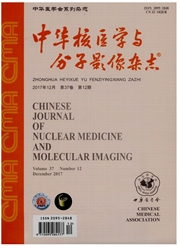

 中文摘要:
中文摘要:
目的通过制备携带NIS及EGFP基因的重组慢病毒并转染骨髓间充质干细胞(BMSCs),探讨NIS基因监测BMSCs向颅内脑胶质瘤迁移的可行性。方法将NIS及EGFP基因片段分别亚克隆至慢病毒载体pLVX-puro,制备慢病毒pLVX-CMV-NIS-EGFP,同时构建对照组慢病毒pLVX-CMV-O-EGFP。分离培养BMSCs,转染后经嘌呤霉素筛选,得到稳定干细胞株BMSCs-NIS-EGFP及对照组干细胞株BMSCs-EGFP。Westernblot分析NIS蛋白在细胞中的表达。通过摄碘实验、NaClO4抑制实验验证NIS蛋白的功能。制备裸鼠颅内脑胶质瘤模型,经尾静脉注入BMSCs-NIS-EGFP,24h后行125^ImicroSPECT显像,观察N1S作为报告基因监测BMSCs-NIS-EGFP向颅内脑胶质瘤迁移的情况。结果成功构建并制备重组慢病毒pLVX-CMV-NIS-EGFP及pLVX-CMV一0-EGFP,完成BMSCs的分离培养。病毒转染经嘌呤霉素筛选得到稳定干细胞株BMSCs-NIS-EGFP及BMSCs-EGFP。Westernblot显示NIS基因在BMSCs-NIS-EGFP中大量表达.而在BMSCs-EGFP中无表达。细胞摄碘实验显示BMSCs-NIS-EGFP细胞具有摄碘功能,30min摄碘峰值是对照组BMSCs.EGFP细胞的近10倍,且其摄碘可被NaClO4显著抑制。成功制备裸鼠脑胶质瘤模型,面crosPEcT显像显示颅内脑胶质瘤部位有明显的125^I放射性摄取增高。结论重组慢病毒pLVX-CMV-N1S.EGFP可使NIS基因在BMSCs中表达并介导125^I的摄取,NIS基因可有效监测BMSCs向颅内脑胶质瘤的迁移,这为开展以BMSCs为载体、由NIS介导的脑胶质瘤基因靶向治疗奠定了基础。
 英文摘要:
英文摘要:
Objective To construct a recombinant lentiviral expression vector containing NIS and EGFP gene, and to explore the feasibility of NIS gene for monitoring the bone marrow derived mesenchymal stem cells (BMSCs) migration to the intracranial giioma. Methods The NIS and EGFP gene fragments were subcloned into lentiviral vector pLVX-puro, then packaged and amplified in HEK293T cells to obtain recombinant lentivirus pLVX-CMV-NIS-EGFP, pLVX-CMV-O-EGFP was constructed as control. BMSCs were isolated, cultured, and transfected by lentivirus. The antibiotic-resistant transfected BMSCs (BMSCs- NIS-EGFP and BMSCs-EGFP) were selected. The expression of NIS gene was examined by Western blot. Functional NIS activity was confirmed by the uptake of 125^I and the inhibition effect of NaClO4. The nucle mice intraeranial glioma models were established. MieroSPECT was performed at 24 h post BMSCs-NIS-EGFP in- jection via the tail vein. Results pLVX-CMV-NIS-EGFP and pLVX-CMV-O-EGFP were successfully con- strueted and packaged. BMSCs were successfully isolated and cultured. Stable cell lines BMSCs-NIS-EGFP and BMSCs-EGFP were constructed after lentivirus transfection and puromyein selection. The expression of NIS gene was detected by Western blot in BMSCs-NIS-EGFP, but not in BMSCs-EGFP. BMSCs-N1S-EGFP showed significantly more uptake of 125^I(nearly 10 times than the uptake in BMSCs-EGFP) and the uptake could be significantly inhibited by NaCIO4. The nude mice intracranial glioma models were successfully establishedand the BMSCs-NIS-EGFP in glioma foci could be visualized by microSPECT imaging at 24 h post injection. Conclusions A recombinant lentivirus containing NIS gene could be successfully constructed for monitoring BMSCs migration towards intracranial glioma. It might provide evidence on the research of BMSCs and NIS gene mediated therapy for glioma.
 同期刊论文项目
同期刊论文项目
 同项目期刊论文
同项目期刊论文
 期刊信息
期刊信息
